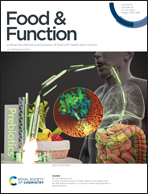The potential mechanisms of Macrocystis pyrifera polysaccharides mitigating type 2 diabetes in rats
Abstract
Our previous studies have proved that the anti-digestive polysaccharide from Macrocystis pyrifera possesses potential hypoglycemic and lipid-lowering activities; however, its potential mechanisms for improving diabetes have not been elucidated. The current study was aimed to determine the anti-diabetic effects and possible mechanisms of Macrocystis pyrifera polysaccharides (MPP) in diabetic rats. After 8-week MPP treatment, the serum profiles, gut bacteria composition and relative gene expressions of rats were determined. MPP administration effectively ameliorated the diabetic symptoms, dyslipidemia, liver and kidney damage, oxidative stress and chronic inflammation in diabetic rats. In addition, MPP treatment could also notably improve the microbial dysbiosis by increasing the beneficial bacteria and decreasing a bacterial pathogen in the diabetic rats. The RT-qPCR analysis indicated that MPP intervention significantly up-regulated the IRS/PI3K/AKT signaling pathway and down-regulated the relative expressions of glucose-6-phosphatase (G-6-Pase), phosphoenolpyruvate carboxykinase (PEPCK), acetyl-CoA carboxylase (ACC), hydroxymethylglutaryl CoA reductase (HMGCR) and sterol regulatory element binding protein 1c (SREBP-1c) in diabetic rats. These results demonstrated that MPP had the potential to be exploited as functional foods or pharmaceutical supplements for preventing and treating diabetes.



 Please wait while we load your content...
Please wait while we load your content...